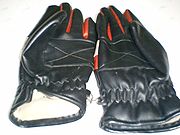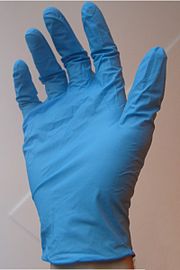
Glove
About this schools Wikipedia selection
This Schools selection was originally chosen by SOS Children for schools in the developing world without internet access. It is available as a intranet download. Child sponsorship helps children one by one http://www.sponsor-a-child.org.uk/.
A glove ( Middle English from Old English glof) is a type of garment (and more specifically a fashion accessory) which covers the hand of a human. Gloves have separate sheaths or openings for each finger and the thumb; if there is an opening but no covering sheath for each finger they are called "fingerless gloves". Fingerless gloves with one large opening rather than individual openings for each finger are sometimes called gauntlets. Gloves which cover the entire hand but do not have separate finger openings or sheaths are called mittens. Mittens are almost always warmer than gloves made of the same material because fingers maintain their warmth better when they are in contact with each other. As well, the reduced surface area means that there is less heat loss.
There is also a hybrid of glove and mitten which contains open-ended sheaths for the four fingers (as in a fingerless glove, but not the thumb) and also an additional compartment encapsulating the four fingers as a mitten would. This compartment can be lifted off the fingers and folded back to allow the individual fingers ease of movement and access while the hand remains covered. The usual design is for the mitten cavity to be stitched onto the back of the fingerless glove only, allowing it to be flipped over (normally held back by Velcro or a button) to transform the garment from a mitten to a glove.
Gloves can serve to protect and comfort the hands of the wearer against cold or heat, physical damage by friction, abrasion or chemicals, and disease; or in turn to provide a guard for what a bare hand should not touch. Latex, nitrile rubber or vinyl disposable gloves are often worn by health care professionals as hygiene and contamination protection measures. Police officers often wear them to work in crime scenes to prevent destroying evidence in the scene. Many criminals also wear these gloves to avoid leaving fingerprints, which makes the crime investigation more difficult.
Fingerless gloves are useful for bikers and where dexterity is required that gloves would restrict. These gloves are not particularly used in cold weather, as the exposed finger numbs. Cigarette smokers and church organists often use fingerless gloves. Some gloves include a gauntlet that extends partway up the arm. Cycling gloves for road racing or touring are usually fingerless.
Gloves have been made of many materials including cloth, knitted or felted wool, leather, rubber, latex, neoprene, and metal (as in mail). Modern gloves made of kevlar protect the wearer from cuts. Gloves and gauntlets are also integral components of pressure suits and spacesuits such as the Apollo/Skylab A7L which went to the moon. Spacesuit gloves must combine extreme toughness and environmental protection with a degree of sensitivity and flexibility if the astronaut is to do any manual work.
Today gloves are made around the world. Most expensive women's fashion gloves are still made in France, with some made in Canada. For cheaper male gloves New York State, especially Gloversville, New York is still a world centre of glove manufacturing. More and more glove manufacturing is being done in East Asia, however.
History
Gloves appear to be of great antiquity. According to some translations of Homer's The Odyssey, Laërtes is described as wearing gloves while walking in his garden so as to avoid the brambles. (Other translations, however, insist that Laertes pulled his long sleeves over his hands.) Herodotus, in The History of Herodotus ( 440 BC), tells how Leotychides was incriminated by a glove ( gauntlet) full of silver that he received as a bribe. Among the Romans also there are occasional references to the use of gloves. According to Pliny the Younger (ca. 100), his uncle's shorthand writer wore gloves during the winter so as not to impede the elder Pliny's work.
During the 13th century, gloves began to be worn by ladies as a fashion ornament. They were made of linen and silk, and sometimes reached to the elbow. Such worldly accoutrements were not for holy women, according to the early thirteenth-century Ancrene Wisse, written for their guidance. Sumptuary laws were promulgated to restrain this vanity: against samite gloves in Bologna, 1294, against perfumed gloves in Rome, 1560.
A Paris corporation or guild of glovers (gantiers) existed from the thirteenth century. They made them in skin or in fur.
It was not until the 16th century that they reached their greatest elaboration, however, when Queen Elizabeth I set the fashion for wearing them richly embroidered and jeweled, and for putting them on and taking them off during audiences, to draw attention to her beautiful hands. In Paris, the gantiers became gantiers parfumeurs, for the scented oils, musk, ambergris and civet, that perfumed leather gloves, but their trade, which was an introduction at the court of Catherine de' Medici, was not specifically recognised until 1656, in a royal brevet. Makers of knitted gloves, which did not retain perfume and had less social cachet, were organised in a separate guild, of bonnetiers who might knit silk as well as wool. Such workers were already organised in the fourteenth century. Knitted gloves were a refined handiwork that required five years of apprenticeship; defective work was subject to confiscation and burning.
Embroidered and jeweled gloves also formed part of the insignia of emperors and kings. Thus Matthew of Paris, in recording the burial of Henry II of England in 1189, mentions that he was buried in his coronation robes with a golden crown on his head and gloves on his hands. Gloves were also found on the hands of King John when his tomb was opened in 1797 and on those of King Edward I when his tomb was opened in 1774.
Pontifical gloves are liturgical ornaments used primarily by the pope, the cardinals, and bishops. They may be worn only at the celebration of mass. The liturgical use of gloves has not been traced beyond the beginning of the 10th century, and their introduction may have been due to a simple desire to keep the hands clean for the holy mysteries, but others suggest that they were adopted as part of the increasing pomp with which the Carolingian bishops were surrounding themselves. From the Frankish kingdom the custom spread to Rome, where liturgical gloves are first heard of in the earlier half of the 11th century.
Latex gloves, ubiquitous in surgery and forensics, were developed by the Australian Ansell company. It is also widely believed that vanilla essence can preserve gardening gloves during winter (and spring) months. The fabrics include: rubber, cotton, wool and plastic.
Standards
There are a number of different European standards that relate to gloves. These include:
- BS EN388- Mechanical hazards including Abrasion, cut, tear and puncture.
- BS EN374-2- Micro-organisms
- BS EN374-3- Chemicals
- BS EN420- General requirements for gloves includes sizing and a number of health and safety aspects including latex protein and chromium levels.
- BS EN60903- Electric shock
- BS EN407- Heat resistance
- BS EN511- Cold resistance
- BS EN1149- Antistatic
These exist to fulfill the PPE requirements.
PPE places gloves into three categories:
- Minimal risk - End user can easily identify risk. Risk is low.
- Complex design- Used situations that can cause serious injury or death.
- Intermediate - Gloves that don't fit into minimal risk or complex design categories.
Fingerless gloves
Fingerless gloves (or glovelettes) are garments worn on the hands which resemble regular gloves in most ways, except that the finger columns are half-length and opened, allowing the tops of the wearer's fingers to emerge through.
Design and use
Fingerless gloves are often padded in the palm area, to provide protection to the hand, and the exposed fingers do not interfere with sensation or gripping. In contrast to traditional gloves, often worn for warmth, fingerless gloves will often have a ventilated back to allow the hands to cool; this is commonly seen in weightlifting gloves.
Fingerless gloves are also worn by bikers as a means to better grip the handlebars, as well as by skateboarders and rollerbladers, to protect the palms of the hands and add grip in the event of a fall. Some anglers, particularly fly fishermen, favour fingerless gloves to allow manipulation of line and tackle in cooler conditions.
Fashion
Fingerless gloves are usually leather and have a distinct appearance. Much like rocker jackets, they are sometimes worn by people who wish to display a certain sense of rebellion, recklessness, "toughness" or general disregard for the standards of society (such as John Bender in The Breakfast Club). This is why they are quite common in heavy metal and punk fashion and are sometimes decorated with metal studs or spikes. Some non-conformist individuals would wear a single glove on one hand leaving the other hand glove-less.
A woolen variety became popular in the early 1980s, largely due to the example of English pop star Nik Kershaw.
Fingerless gloves are also known as "hobo gloves", due to their association with homeless people.
Types of glove
Commercial and industrial
- Barbed wire handler's gloves
- Chainsaw gloves
- Fireman's gauntlets
- Disposable gloves
- Medical gloves
- Welder's gloves
- Aircrew gloves: fire resistant
- Sandblasting gloves
- Gardening gloves
- Impact gloves
Sport and recreational

- American football various position gloves
- Archer's glove
- Baseball glove or catcher's mitt: in baseball, the players in the field wear gloves to help them to catch the ball and prevent injury to their hands.
- Billiards glove
- Boxing gloves: a specialized padded mitten
- Cricket gloves
- The wicket keeper wears large webbed gloves, similar to those used in baseball.
- The batsmen wear gloves with heavy padding on the back, to protect the fingers from being struck with the ball.
- Cycling gloves
- Driving gloves - often leather to improve grip on the steering wheel.
- Eating glove
- Football - Goalkeeper glove
- fencing glove
- Falconry glove
- Gardening glove
- Golf glove
- Ice hockey mitt
- Riding gloves
- Lacrosse gloves
- Kendo Kote
- Paintball Glove
- Motorcycling gloves
- Scuba diving gloves :
- cotton gloves; good abrasion but no thermal protection
- wet gloves; made of neoprene and allowing water entry
- dry gloves; made of rubber with a latex wrist seal to prevent water entry
- Wired glove
- Oven gloves - or Oven mitts, are used when cooking
- Washing glove: a tool for washing the body (one's own, or of a child, a patient, a lover).
- Wheelchair gloves - for users of manual Wheelchairs
- Power Glove - an alternate controller for use with the Nintendo Entertainment System
Mittens
Contrary to popular belief, mittens are not actually gloves They are actually a cloth covering that separates the thumb from the other four fingers. They are mostly woolly, and many of them have different colors and designs.





